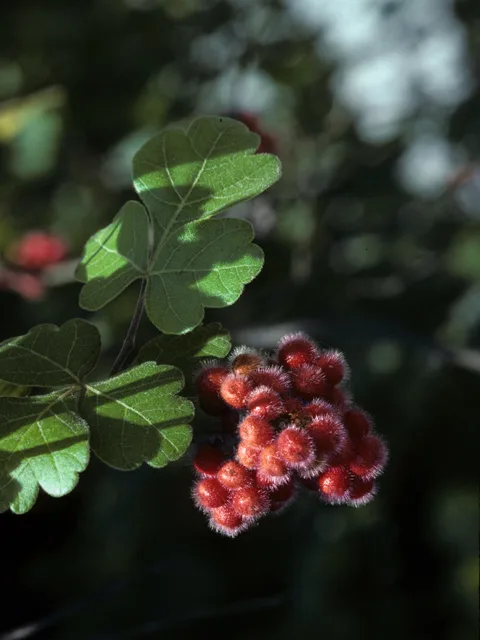For some, the name “sumac” can conjure up negative connotations. Whether it was past encounters with Poison Sumac (not found in North Texas) or the invasive Chinese Sumac, many people hesitate to bring Sumacs into their gardens. However, Fragrant or Aromatic Sumac (Rhus aromatica) is a versatile native shrub, offering many virtues for both homeowners and wildlife. With its general availability at local nurseries and native plant sales, it is a plant worthy of consideration for your landscape.

A Closer Look at Rhus Aromatica
For those new to North Texas native plants, Fragrant Sumac is a deciduous shrub native to large portions of the United States, including North Texas. It typically reaches 2 – 6 feet tall and can sprawl to form a dense thicket. Its trifoliate leaves are reminiscent of clover. As autumn approaches, the foliage can become a blend of colors – orange, red, and purple. Plus, when its leaves and twigs are crushed, they release a citrusy aroma, adding another sensory benefit to your landscape.
In early spring, tiny yellow flowers emerge from the branch tips, followed by separate male and female flower clusters. In late summer, the female plants produce clusters of red berries that persist well into winter, adding color to your garden even during the winter. Their flowers may appear modest, but they play an essential role in supporting pollinators, such as bees and butterflies.
Finding a Home for Fragrant Sumac
This versatile shrub thrives in a variety of well-drained soils, adapting to sandy, loamy, and even clay. Sunny to partial shade locations are best for it to flourish. As a native Texan, Fragrant Sumac can tolerate droughts and requires minimal irrigation once established. This means less work for you and less strain on your water bill.
The most important factor in placing Aromatic Sumac is planning for its spreading nature. With its suckering tendencies, it is ideal for open areas where it can spread without infringing on other plants.
A Feast for Wildlife

Beyond its aesthetic appeal, Fragrant Sumac provides great value to Texas wildlife. The colorful berries provide a critical winter food source for numerous bird species, including Cardinals, Blue Jays, and Cedar Waxwings. Their dense growth habit offers an ideal habitat for small birds to nest and seek shelter. Small mammals like rabbits and squirrels also enjoy the fruit.
As mentioned earlier, the blooms attract pollinators, and are the larval hosts for the Red-banded Hairstreak butterfly.
Where to Plant This Native Texan
With its adaptability and hardiness, there are many options for incorporating Fragrant Sumac into your landscape – below are some ideas:

- Foundation Planting: Use its compact size and vibrant fall foliage to add interest to the base of your home.
- Privacy Screen: Its dense foliage and spreading habit make it ideal for creating natural privacy barriers.
- Wildscaping: Introduce it to wildflower meadows or rocky slopes for a naturalized landscape aesthetic.
- Erosion Control: Plant on slopes or hillsides to help prevent erosion due to its robust root system and ground-covering growth.
- Pollinator Garden: Include it with other host and nectar plants to offer a consistent food source and shelter for butterflies, bees, and other pollinators.
Benefits for Homeowners
Fragrant Sumac also offers multiple advantages for your home landscape:
- Low Maintenance: Once established, it requires minimal watering and infrequent pruning.
- Year-round Interest: Offers visual appeal throughout the year, from spring’s blooms and fragrant foliage to summer’s lush greenery and fall’s multi-hued display.
- Unique Sensory Experience: The refreshing citrus scent of its leaves and branches adds a distinct dimension to your landscape.
- Habitat Creation: By attracting wildlife, fragrant sumac adds life to your garden, enhancing its natural beauty.
Embrace the Sumac
Fragrant Sumac can offer your landscape a wealth of benefits. Its low maintenance requirements and adaptability make it a friend to both nature and homeowners. Rhus aromatica’s adaptability and resilience make it a wise addition to many growing locations throughout North Texas.
